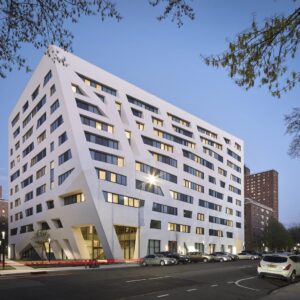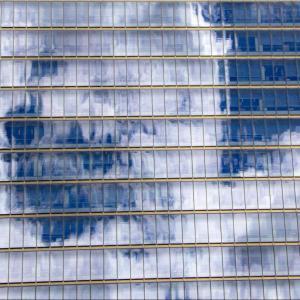Preserving architecture through facade restoration preserves a region’s history, legacy, and culture. Facade restoration also protects the environment by reusing existing structures, lessening landfill waste, and using natural resources.
However, while facade restoration encourages the preservation of original materials, building components that are damaged beyond repair or don’t meet current codes will need upgrading or replacement. In addition, all improvements must strive to maintain the original aesthetics and building’s character, by preserving the structure’s and surroundings’ architectural style.
Sto Products has a superior-innovative solution for building facade restoration for preserving architecture – Sto’s The A.R.T. of reStore® program. Sto products also enhance a building’s sustainability, energy efficiency, safety, durability, and occupant comfort level.
The Renovation of Union Towers
A StoTherm® ci System overclad gave the Union Towers multi-family high rise an energy efficient facelift.

Architect Bob MacLeod, RA, of McKinnell, McKinnell & Taylor Inc. chose Sto reStore® Level 3 Overclad with StoGuard®, Stolit® Lotusan®, and StoTherm® ci to provide a cost-effective solution to deliver the additional insulation that was needed to upgrade the 50-year-old structure’s energy efficiency.
The Pros of Preserving Architecture
Historic architecture preservation and restoration can provide sustainable, economic, and cultural advantages to building owners and the community. However, achieving these benefits often requires a qualified, experienced historic building restoration professional.
Don’t hesitate to contact one of Sto’s facade restoration experts for preserving architecture at (800) 221-2397 or click here.
Economic Benefits of Historic Facade Restoration
- Facade restoration is done with high-quality, durable building materials. For instance, historic masonry restoration preserves historic facades’ character and cultural value.
- Rehabilitation typically costs less than new construction.
- Facade restoration increases the structure’s resale values and attracts business, which can help the economic viability of historic spaces.
- Facade restoration uses existing space, which quickens occupancy.
Sustainability Advantages of Facade Restoration
Energy Savings
- No energy needed for new construction and demolition
- Reuse of embodied energy in building systems and materials
- Retrofitting allows for more energy-efficient building products, like wall systems, doors, windows, etc.
Recycling of Building Products
- Lessens the need for new materials, saving natural resources
- Reduces construction and demolition debris to decrease landfill waste
- Reduces hazardous debris
Cultural Benefits of Facade Restoration
Facade restoration for preserving architecture helps retain a community’s history, appeal, and aesthetics.
The National Historic Preservation Act (NHPA)
In 1966, Congress instituted the National Historic Preservation Act (NHPA) to mandate the use of historic structures for the public’s benefit and to preserve our national heritage. After it passed, the Secretary of the Interior created the Standards for the Treatment of Historic Properties to guide historic building preservation practice and design in America. Moreover, all grant-in-aid projects assisted through the National Historic Preservation Fund need the Standards for the Treatment of Historic Properties (codified in 36 C.F.R. 68).
The Standards provide four approaches to treating historic properties: Preservation, Rehabilitation, Reconstruction, and Restoration. The approach depends on the property’s historical significance, proposed use, intended interpretation, and physical condition. The standards allow for code-required work to make properties functional, including the sensitive and limited upgrading of electrical, plumbing, and mechanical systems.
Preservation
Preservation measures aim to sustain a historic structure’s integrity, form, and products. The work includes protecting and stabilizing the building, focusing on ongoing maintenance and repairs of historical components and materials rather than large-scale replacement and new construction.
NOTE: Preservation does not include new exterior additions.
Rehabilitation
Rehabilitation involves repairing, adding, and altering a historic building while preserving those portions which convey its architectural, cultural, or historical values. Notably, rehabilitation allows for replacing deteriorated features; however, the replacements must match the old color, texture, design, and materials, if possible.
Reconstruction
Reconstruction involves designing and building a new structure to match a building’s aesthetics from a specific historical time.
Restoration
Restoration involves accurately depicting a property’s character, features, and form from a particular time. The process consists in removing building parts from other periods and reconstructing missing components from the restoration time. Additionally, builders can replace deteriorated features with new ones that match the original color, texture, design, and materials.
Sto’s Complete Approach to Facade Restoration for Preserving Architecture
Sto Corp. offers an innovative solution to building facade restoration for preserving architecture – the Sto A.R.T. of reStore® – aesthetics, transformation, and repair. The A.R.T. of reStore® has all the materials and services needed to maintain and restore a building’s facade. Furthermore, our product’s engineering can improve the building’s sustainability, energy efficiency, integrity, safety, and occupant comfort level.
ReStore® provides four levels of restoration, from simple maintenance to dirt and mold removal as well as a complete facade restoration with all the necessary products and support.
- Clean and Recoat: A program to remove dirt, mold, and mildew while updating or refreshing the facade’s color.
- Repair and Refinish: The program repairs minor damage to EIFS or stucco facades before significant damage happens.
- Overclad: A cost-effective program to fix moisture intrusion problems and enhance the facade’s energy efficiency and aesthetic appeal.
- Remove and Reclad: New cladding offers a cost-efficient solution for deteriorated exterior walls beyond repair.
Sto’s Comprehensive Repair Guide
Sto’s Comprehensive Repair Guide addresses 30 common problems affecting EIFS, stucco, concrete, and masonry with step-by-step illustrated solutions.
Click here to download Sto’s Repair Guide.
Sto’s Endless Aesthetic Options
Sto provides the aesthetic flexibility to replicate any historic facade with complete design freedom in endless texture, color and material choices. Sto’s newest finishes, StoCast prefabricated resin cast shapes, offer the ability to replicate historic brick or wood facades with a high-efficiency, tested and code-compliant Sto wall system. Sto Studio can also assist with suggestions on materials, colors, and textures to help preserve your historic building’s architecture with an attractive, high-performing, sustainable, fully-engineered cladding system.
Sto Studio
Sto Studio can assist your design process to ensure that your historic facade restoration will attain its maximum potential. We work to create a complete facade concept, including color and material options, to preserve the original character and aesthetics of the building. Additionally, we generate a series of color renderings that will help determine the most acceptable facade to preserve the cultural architecture of the building.
Restoration of the Lido Beach Towers, Long Island, NY USA
Restoration of the century-old Lido Beach Towers condominium community preserved its original architecture. It also showcases StoTherm® ci Lotusan® EIFS potential as a retrofit method for deteriorating buildings. The aesthetically pleasing second skin approach of EIFS tremendously improved the structure’s sustainability and energy efficiency.
StoTherm® ci
Sto’s continuous insulation wall system, StoTherm ci, is an energy-efficient, high-performance wall cladding. It combines proven components: StoGuard® (a water-resistive air barrier), StoTherm® insulated cladding and drainage, and allows for the use of a wide variety of Sto textured finishes, Sto Specialty finishes, or StoCast surface components.
Best Practices for Facade Restoration for Preserving Architecture
The best practices for facade restoration should preserve the structure’s architecture while repairing and retaining the original building’s aesthetic features. It should also allow new equipment and technologies to meet applicable codes, ensure occupants’ safety and comfort, and protect the environment through sustainable building products and practices.
Don’t hesitate to contact the Sto professionals for more on how our A.R.T. of reStore™ solutions and Sto Studio can help you with facade restoration and preserving architecture.


